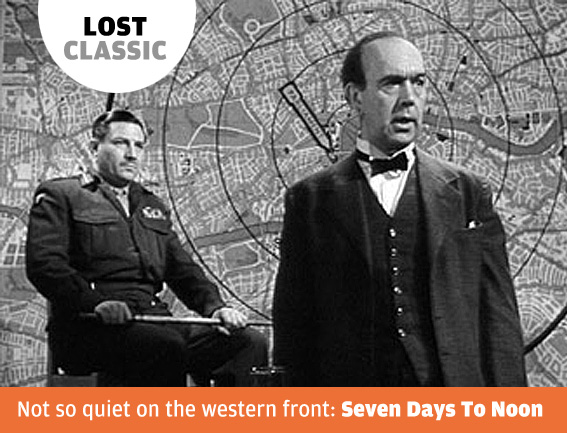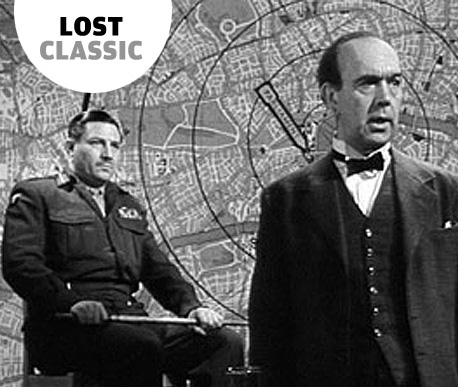
Released last year for the first time on DVD, the Boulting brothers’ Seven Days to Noon is nearly sixty years old now but seems more relevant and frightening than ever. As well as working as an entertaining thriller it offers an interesting insight into how people might have dealt with the ultimate threat of annihilation right on their doorsteps in the immediate post-war years.
The film deals with the threat posed by Prof. John Willingdon, a scientist who has succumbed to the pressure of work and taken an atomic bomb from the magazine at his research station. He threatens to explode the device in the heart of London unless the Government renounces its policy on weapons manufacture. The narrative cuts between the manhunt undertaken by the Authorities who try to thwart Willingdon’s destructive plan, Willingdon’s painstaking efforts to elude capture and the rapidly organised mass exodus of the Capital’s population.
The thematic potency of Seven Days to Noon is clearly and quite deliberately driven by familiar images of wartime Britain; we see military leaders attending a Downing Street briefing, eager to take part in the new emergency, a shadowy operations room complete with a large map of Central London, prime-ministerial speeches with distinctly Churchillian overtones and an evacuation carried out with all the stoical acceptance and cheerful resilience associated with the British public’s projected response to the crises of the Second World War.
Placing the reaction to the unfolding atomic threat in this nostalgic light served something of an instructive purpose for its intended audience; while the film does not shy away from the potential horrors of atomic warfare it positions the response of the Authorities and the population to it firmly in the respected tradition put forward by the many British wartime propaganda feature films and documentaries: that London can take it and that Londoners will, by and large, conduct themselves in an orderly, civilised manner in times of crisis, in compliance with the wishes of their civil and military leaders. This portrait of deference and cheery stoicism in the face of adversity is visually reinforced with the liberal inclusion of images of social permanence; extensive location filming featuring iconic London landmarks such as Big Ben, St. Paul’s Cathedral and the Cenotaph are intentionally planted as reassuring visual reminders of how London stood firm against past aggressors and why its people should do so against the new threat.
Many of the film’s characters are similarly reassuring pillars of the community. Andre Morell’s steadfast Superintendent Folland of Scotland Yard for example, doggedly tracking Willingdon down, even Joan Hickson’s pusillanimous landlady Mrs. Peckett, although stereotypical, offers a familiar ingredient of normality to proceedings. Indeed, by acknowledging the contribution of ‘The People of London’ in the opening credits, the Boultings are holding up a significant section of their actual audience as an embodiment of the welcome constancy of the British way of life and an affirmation of the collective national character under trying circumstances.
Released theatrically in 1950, the film is arguably the first British drama to touch on emerging Cold War anxieties and to some extent trades in the sort of one-dimensional representations that would come to be characteristic of McCarthyism. Willingdon is a manifestation of The Enemy Within, on one level an example of the staple ‘boffin-as-threat’ character seen in numerous subsequent 50s and 60s political thrillers. His police profile reveals his education at Cambridge in the early 1920s; an audience in 1950 would be intended to take this as a reference to the assembly of left-leaning intellectuals associated with that university at that time, and draw ‘suitable’ conclusions about Willingdon’s background and motives. On another level considerable effort is taken to sketch in Willingdon’s recent past and home life in order to lend some sympathy and thought-through rationale to his actions. This approach adds considerable substance to Willingdon’s motives. Demonstrating the ease with which he is able to mount the threat and walk among the unwitting people of London with a device small enough to fit inside a Gladstone bag adds a chilling immediacy that has endured.
Several ingredients in Seven Days to Noon make it an interesting comparator to later films covering similar territory. For example, deference to authority is clearly intact. The population accept decisions taken and generally comply with the evacuation. Any deviation from this compliance takes vignette form; one dimensional, stereotypical caricatures such as the silhouetted looter shot during the curfew and the spiv at the railway station selling rooms in Brighton to the fleeing masses. These representations, themselves throwbacks to the war years, help reinforce the message that such behaviour goes again the national interest. Folland’s questioning of Willingdon’s parish vicar illustrates that, within the context of the unfolding situation, the confidence between the clergyman and his parishioner takes a back seat to the threat to national security. Once Folland makes this very broadly apparent, the vicar is prepared to share his conversations with Willingdon.
The way that the style of post-war Media reporting was used to lend realism to the production is also interesting. The Boultings drew upon the visual language developed through the War Office Film Unit and numerous wartime feature films to evoke a feeling of reality. They also used an actual NBC journalist in scenes of reportage for additional authenticity.
A further theme running through the film is the counter-productive and destructive force of science and its proponents. Willingdon is the crazed research scientist, ready and willing to unleash the product of his scientific labours upon London. Therefore the narrative attempts to show the results of Man playing God in the sense that the result of this scientific misappropriation unleashes a biblical punishment. We learn that Willingdon’s father was the Bishop of Hampton and that he regarded his local parish vicar as a close friend and confidante. He has lost faith in Mankind’s ability to do God’s bidding. This internal crisis lies at the heart of his neurosis. In cod maniac soliloquy he quotes to himself from the Bible, of the fall of Babylon the great city, and sees biblical parallels with his own actions. He seeks solace mid-way through the film in St. Stephens church, ironically bombed during World War II, where he is ultimately tracked down. With this there is the sense that this is Willingdon’s own judgment day, that a divine hand has played a part in the foiling of his plan.
Seven Days To Noon is a must-see for anyone with an interest in the kind of panic/evacuation narratives we have seen a lot of in recent years – 28 Days Later springs to mind – and provides a fascinating bridge between the British wartime stiff-upper-lip and the post-war tension of the WMD age.
